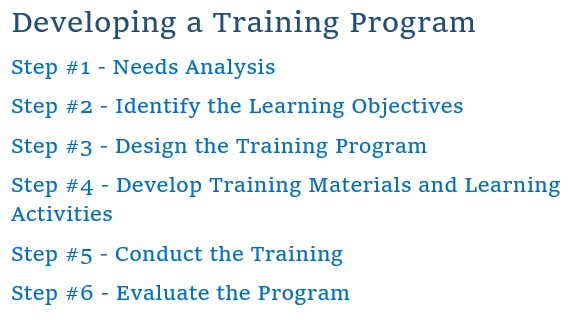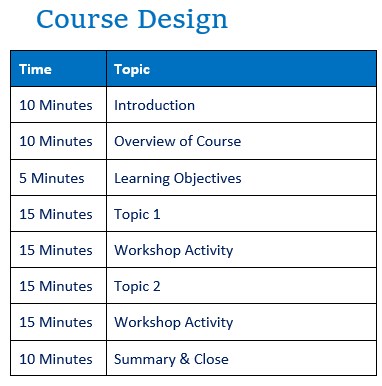Developing a Training Program
Below is a six step process for developing a training program. This road map will help you create an effective training program.
Step #1 – Needs Analysis
The needs analysis is the first phase when developing a training program.
A needs analysis is the process of gathering and analyzing information about a performance issue. There are four main parts to a needs analysis:
- Gather information
- Analyze it
- Draw conclusions
- Make recommendations
This phase focuses on addressing skill and knowledge gaps within an organization. It does this by assessing the knowledge, skills, and attitudes necessary to effectively perform the required job functions and comparing them to the current levels.
In the analysis phase, information is gathered about the intended audience, the issues associated with performance, and the tasks to be completed. The analysis will identify the required level of skill and knowledge as well as the current level of skill and knowledge to determine the gap.
After a needs analysis is complete, it may be determined that training is not the solution, as training does not solve all performance problems. Sometimes the problem may be employee motivation, work processes, resources, or equipment. Therefore, you want to determine if the employees possess the necessary skills or knowledge to perform the job. If they do not then training will probably benefit the employee. However, if they do possess the necessary knowledge and skills, the problem is likely a performance or resource issue. If that is the case, then there is little benefit to develop a training program. Conducting training without assuring there is a training need is a waste of time and resources.
Training may need to be done if:
- Employee’s lack of knowledge
- Employee’s lack of skills
- New processes or procedures
- New equipment
- Behavior needs to be changed
Step #2 – Identify the Learning Objectives
After conducting the needs analysis and determining training is needed, it is time to identify the learning objectives.
Learning objectives are specific statements that clearly describe what the course intends the participants to be able to do as a result of the instruction and activities. Learning objectives identify what behaviors a participant must demonstrate in order to confirm the intended learning took place.
Written learning objectives should contain action verbs that are both observable and measurable. Bloom’s Taxonomy can help frame the objective in concrete terms using action verbs.
Learning objectives should be;
- specific
- measurable
- observable
- written in behavioral terms
Step #3 – Design the Training Program
After the learning objectives are written, you begin to design the training course to meet those objectives.
The design stage should be focused on the framework of the delivery of the training content. Basically, you structure what you want to address at the beginning, middle and end of the training course.
The entire course design should be systematic and logical with each segment linked to and building on the previous. The first part of the design is the introduction. This is where the topic is introduced along with the learning objectives. Also included in the introduction is an overview of the format of the course and any social agreements (break times and how the participants are expected to act).
After the introduction, the tasks that are needed to accomplish the objectives should be segmented and structured into chronological order.
After the tasks are segmented and ordered, strategies regarding the delivery method, content material, technology, and the tools to be used are addressed and placed into the framework.
Strategies include the following:
- Determining your training methods (i.e., lecture, discussion, role-play, simulation, case-study, or games)
- Selecting media (i.e., reference material, workshops, flip charts, diagrams, PowerPoint, or videos)
Step #4 – Develop Training Materials and Learning Activities
After the course is designed and the framework is set, materials and activities are created for the participants in order for them to understand and practice the new knowledge or skills.
Materials include:
- instructor’s guide
- participant’s guide
- job aids / handouts
- presentations
- assessments
Learning activities are experiences that allow the learner to practice applying the new skills and knowledge. The activities should prepare the learner for the assessments which test their knowledge of the topic. These activities can be done as a large group, small group, or as individual assignments.
Activities include:
- written workshops
- role plays
- games
- presentations
- group discussion
Step #5 – Conduct the Training
After the content has been developed, it is time to implement the program.
The training should begin with an introduction to the topics and learning objectives. After which, the materials and activities should be presented in a logical and sequential order according to the program design. An effective training program allows the attendees to actively participate in the learning process and to practice their new skills and knowledge.
Allow attendees time to:
- ask questions
- participate in discussions
- participate in active learning exercises
- apply their knowledge
- share their knowledge
Step #6 – Evaluate the Program
To ensure the training program met the intended objectives and participants are able to implement his or her learning on the job, an evaluation should be completed. Training evaluations are conducted with the intent of obtaining information on the effectiveness of the training program. The standard way to do this is to use Kirkpatrick’s Four Levels of Evaluation.
Kirkpatrick’s model evaluates the effectiveness of the training at four different levels with each level building on the previous level(s). All four levels of evaluation have their own elements, significance, benefits, and challenges.
The four levels of evaluation are:
- Reaction
- Learning
- Behavior
- Results
The outcomes of the evaluation phase will help you modify future training strategies to better meet objectives and implement learning to positively affect job performance.




